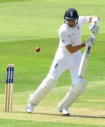Graham Thorpe – England’s Forgotten Maestro
Gareth Bland |
In an eighteen month stretch between March 1968 and September 1969 four very different future England batsmen were born. Two, in the form of Michael Atherton and Nasser Hussain, would go on to captain England. Born within five days of each other in March 1968, the Lancastrian Atherton, and Mumbai-born Essex Boy Hussain each maximized their talent with the bat and led by example once they become the team’s leader. The other two – Thorpe and Ramprakash – were more mercurial and often difficult to fathom. Although Ramprakash sloughed off his reputation as English cricket’s nearly man at Test level by reaching a century of centuries largely through his late career flowering with Surrey, Graham Thorpe is perhaps still less understood, and less appreciated, than either his former Surrey teammate or international colleagues Atherton and Hussain.
While Atherton debuted in the dreadful 4-0 home thumping that was the 1989 Ashes series, Hussain began in the Caribbean tour which followed in 1989/90. Ramprakash began his international career against West Indies in 1991 and, despite never topping the twenties that summer, looked the part. Graham Thorpe was the last of the quartet to enter international cricket when he made a Test century on debut against Australia at Trent Bridge in 1993. Thorpe was also the oldest to debut, at 24, while the other three all made their introductions to the Test arena at the age of 22. The last to depart the international stage in 2005, Thorpe is also the one whose record – in sheer statistical terms, at least – stands comparison with the some of the best of his era.
Having made his first-class debut in the summer of 1988, the Surrey left-hander established himself as a regular in the 1989 season. After four overseas tours with England A, Thorpe finally made his England debut against Australia in that summer’s Trent Bridge Test. At the age of 24, he would go on to become a mainstay of the English middle-order until his sudden exit at the age of 36 in 2005.
Unlike Atherton, Ramprakash and Hussain, Thorpe never played alongside Botham, Gower, or Lamb. Although he played the first eighteen months of his international career alongside Graham Gooch, the Surrey man never imbibed the culture of the champagne-set as personified by those charismatic hedonists of the late 70s and the decade and a half which followed. When Botham, Lamb, and latterly Gower all took their leave of international cricket against Pakistan in the summer of 1992, it was at a time when the cult of the eighties dilletante was being brutally phased out.
Just as Thorpe never graced an England lineup with the departing heroes of 1992, he also operated at a time of home terrestrial television and before the arrival of Kevin Pietersen. Indeed, his international career reached its end after the second Test match – his hundredth – against Bangladesh in the summer of 2005. What followed was that series against Australia in the second half of the summer, and the arrival of Pietersen to supplant Thorpe himself.
Following the 2-1 Ashes victory, OBEs, parades, and parties at 10 Downing Street, England’s cricket team became the property of television subscribers and a fan base largely peopled by a travelling band of the comfortably off. Thorpe, then, can be located in a timeframe wedged between two distinct eras. Although he rubbed shoulders as teammates with many of the heroes of 2005, his mainly undemonstrative on-field career came to an end before Michael Vaughan’s men bested Australia that year. As Pietersen’s cocksure approach and pyrotechnics took flight, England’s personality took on a different shade, with Flintoff becoming the most accomplished in a long line of Botham successors. Thorpe’s diligence and calm competence, along with Ramprakash’s earnest and ultimately flawed precocity, and Atherton’s updated Lancastrian take on the M.J.K Smith persona, became almost forgotten totems of a different age.
Which performances, then, were the hallmarks of Thorpe’s international career? In a hundred Test match career where he finished up with an average of 44.66, only against India (35.37) and South Africa (35.88) did his mean dip below 40. He averaged in excess of 50 against New Zealand and Pakistan, 49.42 against Sri Lanka, and 45.74 against the world’s best, the Australians. Similarly, in 27 Tests against the West Indians he struck 1740 at 42.43. Averaging 45.17 in 49 home Tests and 44.16 in 51 overseas contests is also testament to his consistency and mastery of different surfaces. Moreover, batting in his favoured position of number 5, he averaged 56.21 at Test level.
Among Thorpe’s signature innings during his England tenure is his debut 114 in July 1993. Unbeaten when Graham Gooch declared the innings, the left-hander had batted without fuss, but with a positivity and sense of calm which brightened an English summer which, once again, had been typified by some nervy and technically maladroit batting displays. In an attacking sense, very few English batting displays can hold a candle to Thorpe’s 2002 unbeaten double-hundred against New Zealand in Christchurch. Although he was later overshadowed by Nathan Astle’s fastest double-century in Test history, Thorpe’s 200* came from 231 balls and comprised 28 fours and four sixes. It was in early 2001, however, that Thorpe played his most accomplished Test match innings. In the deciding Test of a three-match series against Sri Lanka in Colombo, Thorpe mastered Muralitharan to score an unbeaten 113 out of total of 249. With only Atherton, Trescothick and Vaughan reaching the twenties, Thorpe was out on his own. Similarly, his unbeaten 32 in a winning total of 74-6 led England home to victory in a low scoring match.
Although viewed as a quiet man, Thorpe was no shrinking violet and often had his clashes with authority. Ahead of his return to the England set-up in 2003 Angus Fraser had questioned Thorpe’s ability to conform to the group ethos. David Lloyd, Bumble himself, had also questioned Thorpe’s attitude, basing his views on his experience of the left-hander while England coach during 1996-1999. When the torment of a failing marriage took its toll, Thorpe took an indefinite leave from the game in 2002, only to return and play more sporadically for England until his final retirement in June 2005. His final stretch in England’s middle order, from the South African return in 2003 to that final encore against Bangladesh in 2005, saw him rack up 1511 runs at 54.
Six years after Thorpe’s retirement in 2011, David Gower reckoned him the second-best England bat he had played with or commented on, while his Cricinfo profile lauds him as “the most complete England batter since the Gooch-Gower” era. Although he did not, perhaps, convert as many fifties to hundreds as he should have, the sixteen he did notch were composed in a manner many of his England peers struggled to match. Temperamental and tormented Graham Thorpe may have occasionally been, but he was also one of England’s unsung and underappreciated batting gems of the last thirty years.





Leave a comment